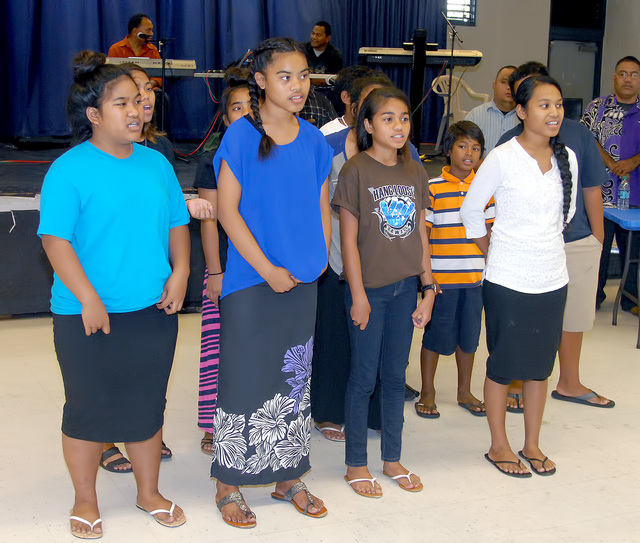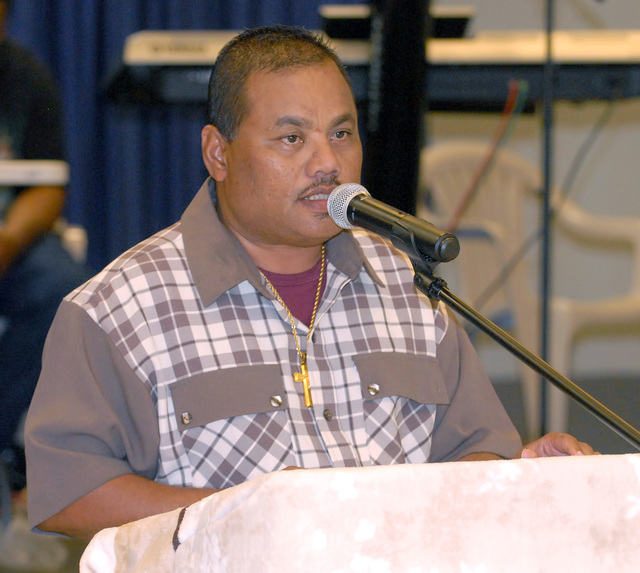KAILUA-KONA — Local politicians, educators and representatives of various Hawaii Island institutions gathered together with members of the Marshallese community at Kealakehe High School Friday night to celebrate the Republic of the Marshall Islands Constitution Day.
KAILUA-KONA — Local politicians, educators and representatives of various Hawaii Island institutions gathered together with members of the Marshallese community at Kealakehe High School Friday night to celebrate the Republic of the Marshall Islands Constitution Day.
The celebration was significant, serving as a symbol of Marshallese independence as well as continued efforts to connect traditional Hawaiian communities with the Marshallese — perhaps the most marginalized ethnic group in the state.
The locale was equally significant, as Kealakehe High was the site of several heated verbal and physical altercations that occurred in 2012 between Micronesian students — a classification encompassing Marshallese and other Pacific islanders from the same region — and students of various alternative ethnic backgrounds after racial tensions boiled over.
The incidents spurred school lockdowns on consecutive days, an early dismissal and one school cancellation. The string of altercations also resulted in calls to police, who subsequently arrested several juveniles.
“A subcommittee was formed after the fights to let new immigrants be recognized and be better known, (dispersing) information about our heritage and why we’re here,” said Walter Lanwi, a Marshallese immigrant and a member of the Next Steps Committee, which supports the Marshallese organizationally and financially in community outreach efforts. “Racial tensions got better in the school because the student body came together and said, ‘What we did was wrong.’ Now, everybody is doing their part.”
Kealakehe principal Wilfred Murakami agreed with Lanwi’s assessment of the state of racial tensions at the school, which led to the ugly series of incidents four years prior.
“I would say things have improved quite a bit,” Murakami said. “What those incidents did was create a better understanding of the diversity and the need for tolerance here on the campus.”
The Marshallese are in need of more than tolerance, however, as thousands of immigrants make new lives in Hawaii. Those needs went hand in hand with celebration as the collective purpose of Friday night’s Constitution Day event, which culminated in athletic tournaments for Marshallese youth in the Old Kona Airport Park over the weekend.
The Department of Health, the West Hawaii Community Health Center and Early Head Start services were among several institutions in attendance to help new arrivals to the island acclimate to life in the United States.
Jasmin Kiernan, Director of Innovation and Transformation at the West Hawaii Community Health Center as well as a member of the Next Steps Committee, said immigrant Marshallese face issues ranging from language barriers to a lack of economic opportunities to concerns about adequate healthcare.
“They’re seeking a better life here,” Kiernan said. “They want to improve their situation, and language is the first factor. There is also some stereotyping going on, and we need to dispel that. The more they become a part of the community, the more inclusive we will be. This event is to promote their culture and help facilitate and empower the Marshallese community to come together and find their voice.”
Allied Forces occupied the Marshall Islands during World War II, and in subsequent years, the United States conducted nuclear weapons testing in the area. Kiernan said aside from depriving many Marshallese of their way of life and forcing them from their homes, side effects from nuclear fallout — such as a susceptibility to thyroid cancer — are still present within the community today.
Kiernan added that healthcare laws, which used to allow all Marshallese immigrants to apply for Medicaid, have been changed. Now, that option is only available for the elderly, children under the age of 18 and pregnant women.
Thus, coverage under the Affordable Care Act is essentially the only option for most Marshallese, but acquiring and managing it is a complicated process, particularly for segments of the population unfamiliar with the concept of medical insurance, let alone its intricacies.
That is where people like Lanwi factor into the equation. Lanwi travels to churches and homes throughout the West Hawaii corridor, dispersing information about deadlines and helping his countrymen and women sign up for coverage.
Lanwi’s efforts are emblematic of the value of community that is pervasive within the Marshallese culture, and which groups like the Next Steps Committee — which assisted with the staging of Constitution Day — are trying to help the Marshallese community turn to their advantage.
Daina Sigra, a student at Konawaena Middle School who came to Hawaii Island from the Marshall Islands fewer than two years ago, said she felt welcome right away despite not speaking a word of English. That was primarily due to the presence of other Marshallese students at her school.
“Making new friends and speaking another language (were the hardest parts),” Sigra said. “(But) we get together to help each other out when things are getting hard. If we need something, we have people to back us up.”
Religion and Marshallese music were heavily emphasized in Friday night’s ceremonies, and speeches were given in or translated to both English and Marshallese. Despite any stereotyping or racism, Lanwi said his community’s cultural values will not change, and the preservation of Marshallese social norms will persist within its Hawaiian factions.
Lanwi, who arrived on the Big Island as an adult, added that in his years here, racism has not been problem he’s encountered consistently. But he’s adopted a sensible and straight-on approach for when it does rear its ugly head.
“I’m a human being like you,” Lanwi said. “When I see racism, I confront it. The color of your blood is the same color as mine.”





